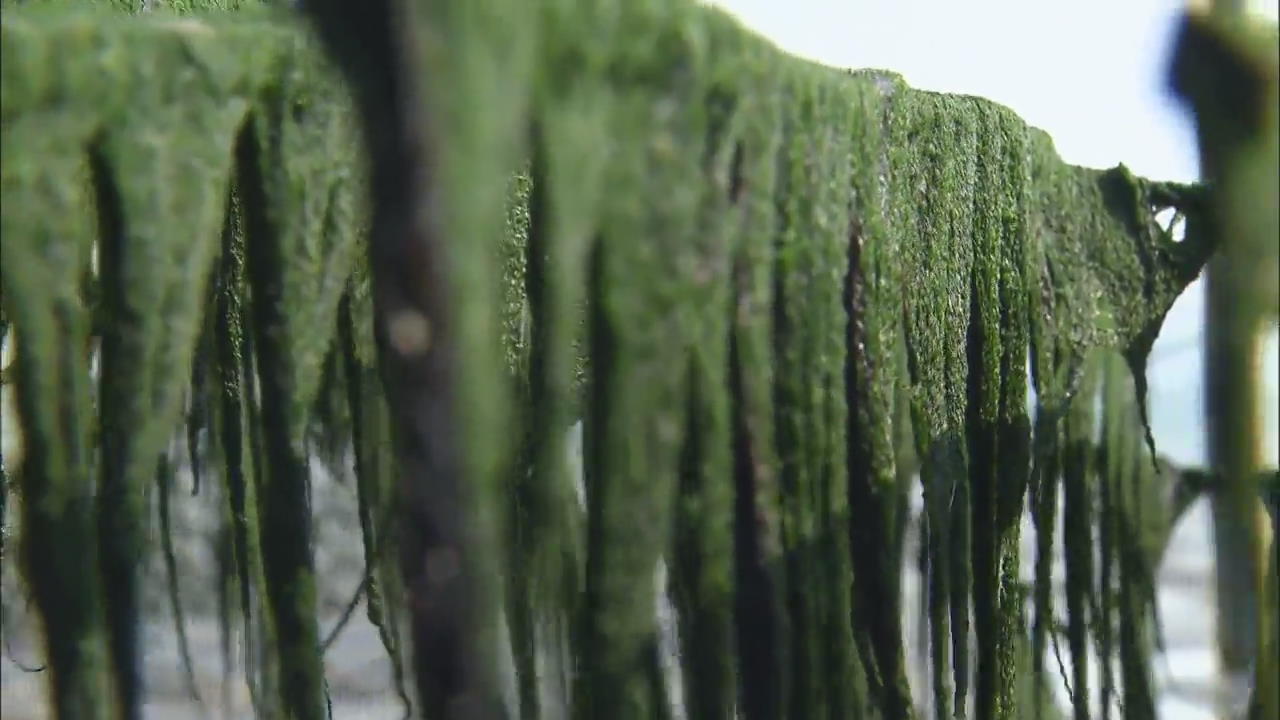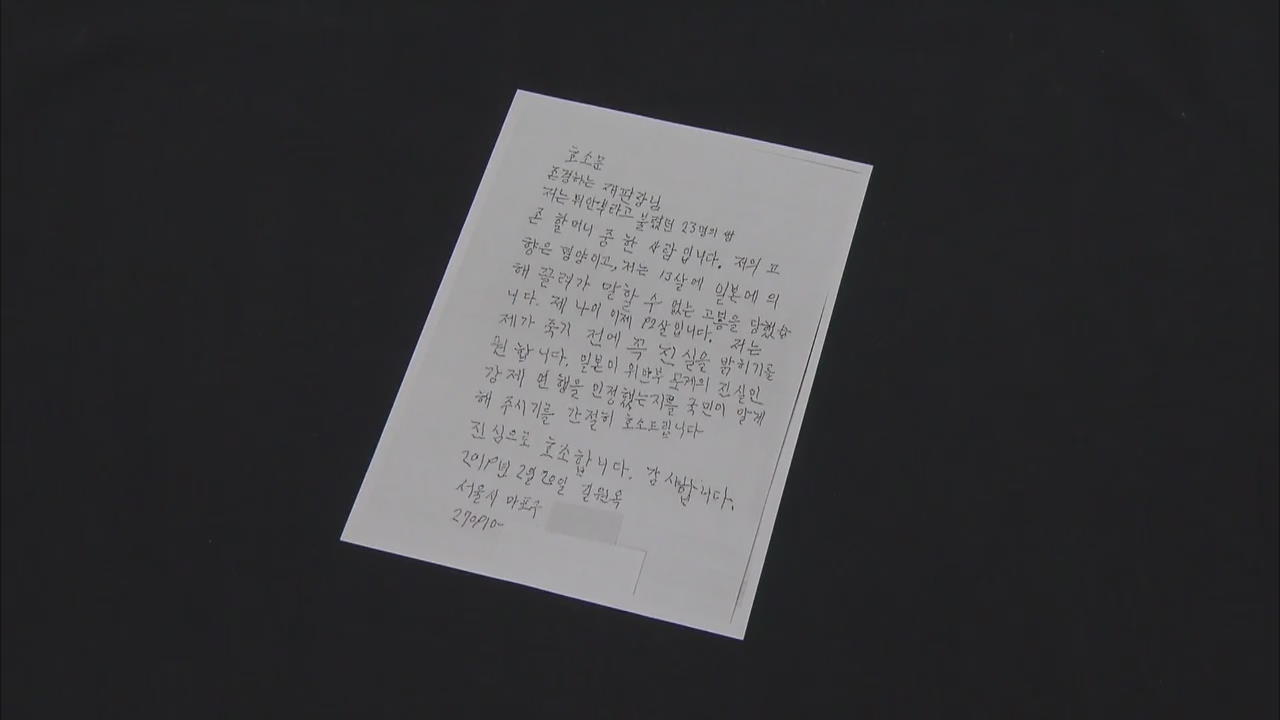Seaweed Farming
입력 2019.03.08 (15:03)
수정 2019.03.08 (15:22)
읽어주기 기능은 크롬기반의
브라우저에서만 사용하실 수 있습니다.
[Anchor Lead]
A leading health food for the Korean winter is the seaweed fulvescens which has been mainly grown on the south coast. But these days, this seaweed called maesaengi in Korean has succeeded in test farming on the west coast as well, raising income prospects for fishermen. Take a look.
[Pkg]
On this vast mudflat field during low tide, rows and rows of bamboo stalks can be seen and loads of green marine plants dangle from the rods. These are seaweed fulvescens called maesaengi in Korean, a winter delicacy in Korea. Maesaengi is a high-protein plant that contains minerals such as iron and calcium. It is also rich in vitamins A and C. This area is Cheonsuman Bay on the west coast where winter's low water temperatures and fast currents made it difficult to raise the seaweed. But Taean county officials recently succeeded in test-farming the plant in the region. The county discovered the adequate level of exposure for the seaweed to grow well in seawater.
[Soundbite] Jang Han-ee(Taean-gun County Office) : "We verified the possibility of production to a certain degree and will try farming at an early date as water temperatures drop faster on the west coast."
Some 39% of all mudflats in Chungcheongnam-do Province are concentrated in Taean county, providing fertile ground for large scale maeseangi farming. Maeseangi is mainly grown during peak winter time and therefore expected to serve as a valuable income source during the low fishing season.
[Soundbite] Jo Dong-yeol(Fisheries chief, Gonam township) : "Fishermen sat idle during winter. The seaweed fulvescens farming has high prospects including added income."
Taean county plans to distribute the farming technology to local fishermen and also provide support for related infrastructure.
A leading health food for the Korean winter is the seaweed fulvescens which has been mainly grown on the south coast. But these days, this seaweed called maesaengi in Korean has succeeded in test farming on the west coast as well, raising income prospects for fishermen. Take a look.
[Pkg]
On this vast mudflat field during low tide, rows and rows of bamboo stalks can be seen and loads of green marine plants dangle from the rods. These are seaweed fulvescens called maesaengi in Korean, a winter delicacy in Korea. Maesaengi is a high-protein plant that contains minerals such as iron and calcium. It is also rich in vitamins A and C. This area is Cheonsuman Bay on the west coast where winter's low water temperatures and fast currents made it difficult to raise the seaweed. But Taean county officials recently succeeded in test-farming the plant in the region. The county discovered the adequate level of exposure for the seaweed to grow well in seawater.
[Soundbite] Jang Han-ee(Taean-gun County Office) : "We verified the possibility of production to a certain degree and will try farming at an early date as water temperatures drop faster on the west coast."
Some 39% of all mudflats in Chungcheongnam-do Province are concentrated in Taean county, providing fertile ground for large scale maeseangi farming. Maeseangi is mainly grown during peak winter time and therefore expected to serve as a valuable income source during the low fishing season.
[Soundbite] Jo Dong-yeol(Fisheries chief, Gonam township) : "Fishermen sat idle during winter. The seaweed fulvescens farming has high prospects including added income."
Taean county plans to distribute the farming technology to local fishermen and also provide support for related infrastructure.
■ 제보하기
▷ 카카오톡 : 'KBS제보' 검색, 채널 추가
▷ 전화 : 02-781-1234, 4444
▷ 이메일 : kbs1234@kbs.co.kr
▷ 유튜브, 네이버, 카카오에서도 KBS뉴스를 구독해주세요!
- Seaweed Farming
-
- 입력 2019-03-08 15:15:40
- 수정2019-03-08 15:22:23

[Anchor Lead]
A leading health food for the Korean winter is the seaweed fulvescens which has been mainly grown on the south coast. But these days, this seaweed called maesaengi in Korean has succeeded in test farming on the west coast as well, raising income prospects for fishermen. Take a look.
[Pkg]
On this vast mudflat field during low tide, rows and rows of bamboo stalks can be seen and loads of green marine plants dangle from the rods. These are seaweed fulvescens called maesaengi in Korean, a winter delicacy in Korea. Maesaengi is a high-protein plant that contains minerals such as iron and calcium. It is also rich in vitamins A and C. This area is Cheonsuman Bay on the west coast where winter's low water temperatures and fast currents made it difficult to raise the seaweed. But Taean county officials recently succeeded in test-farming the plant in the region. The county discovered the adequate level of exposure for the seaweed to grow well in seawater.
[Soundbite] Jang Han-ee(Taean-gun County Office) : "We verified the possibility of production to a certain degree and will try farming at an early date as water temperatures drop faster on the west coast."
Some 39% of all mudflats in Chungcheongnam-do Province are concentrated in Taean county, providing fertile ground for large scale maeseangi farming. Maeseangi is mainly grown during peak winter time and therefore expected to serve as a valuable income source during the low fishing season.
[Soundbite] Jo Dong-yeol(Fisheries chief, Gonam township) : "Fishermen sat idle during winter. The seaweed fulvescens farming has high prospects including added income."
Taean county plans to distribute the farming technology to local fishermen and also provide support for related infrastructure.
A leading health food for the Korean winter is the seaweed fulvescens which has been mainly grown on the south coast. But these days, this seaweed called maesaengi in Korean has succeeded in test farming on the west coast as well, raising income prospects for fishermen. Take a look.
[Pkg]
On this vast mudflat field during low tide, rows and rows of bamboo stalks can be seen and loads of green marine plants dangle from the rods. These are seaweed fulvescens called maesaengi in Korean, a winter delicacy in Korea. Maesaengi is a high-protein plant that contains minerals such as iron and calcium. It is also rich in vitamins A and C. This area is Cheonsuman Bay on the west coast where winter's low water temperatures and fast currents made it difficult to raise the seaweed. But Taean county officials recently succeeded in test-farming the plant in the region. The county discovered the adequate level of exposure for the seaweed to grow well in seawater.
[Soundbite] Jang Han-ee(Taean-gun County Office) : "We verified the possibility of production to a certain degree and will try farming at an early date as water temperatures drop faster on the west coast."
Some 39% of all mudflats in Chungcheongnam-do Province are concentrated in Taean county, providing fertile ground for large scale maeseangi farming. Maeseangi is mainly grown during peak winter time and therefore expected to serve as a valuable income source during the low fishing season.
[Soundbite] Jo Dong-yeol(Fisheries chief, Gonam township) : "Fishermen sat idle during winter. The seaweed fulvescens farming has high prospects including added income."
Taean county plans to distribute the farming technology to local fishermen and also provide support for related infrastructure.
이 기사가 좋으셨다면
-
좋아요
0
-
응원해요
0
-
후속 원해요
0














![[단독] 도이치 주포 “김건희, 내 덕에 떼돈 벌어…22억 원 주문”](/data/news/2025/07/03/20250703_KpuU43.png)
![[단독] “쪽지 얼핏 봤다, 안 받았다”더니…CCTV에선 문건 챙긴 이상민](/data/news/2025/07/03/20250703_Lv3LjI.png)

이 기사에 대한 의견을 남겨주세요.